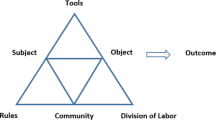Abstract
The aim of the presented work is to outline a theoretical approach to the integration of robots into didactic contexts, with a specific focus on enactive didactic processes. In the first part of the article we will discuss, respectively, the framework of social robotics and that of enaction. In the second section we will theorize about ways to combine these two frameworks into an effective “Enactive Robot Assisted Didactics”. The final discussion will reflect on the central position that robotic design plays in this cross-fertilization, and the outstanding role that the maker movement can play in this undertaking.
Access this chapter
Tax calculation will be finalised at checkout
Purchases are for personal use only
Similar content being viewed by others
References
Varela, F., Thompson, E., Rosch, E.: The Embodied Mind: Cognitive Science and Human Experience. MIT Press, Cambridge (1991)
Rossi, P.G.: Didattica enattiva. Franco Angeli, Milano (2011)
Foerster, H.V.: Erkenntnistheorien und Selbstorganisation. Der Diskurs des Radikalen Konstruktivismus. Suhrkamp, Frankfurt (1987)
Bocchi, G., Damiano, L.: The enactive mind: an epistemological framework for radically embodied didactics. Educ. Sci. Soc. 4(1) (2013)
Maturana, H., Varela, F.: Autopoiesis and Cognition. Reidel, Dordrecht (1980)
Wiener, N.: Cybernetics. Sci. Am. 179(5), 14–19 (1948)
Pitts, W., McCulloch, W.: How we know universals: the perception of auditory and visual forms. Bull. Math. Biophys. 9(1947), 127–147 (1947)
Duffy, B.R., Rooney, C., O’Hare, G.M., O’Donoghue, R.P.S.: What is a social robot? In: 10th Irish Conference on Artificial Intelligence & Cognitive Science. University College Cork, Ireland, 1–3 September 1999
Dumouchel, P., Damiano, D.: Living with Robots. Harvard University Press (2017)
Damiano, L., Dumouchel, P., Lehmann, H.: Towards human–robot affective co-evolution overcoming oppositions in constructing emotions and empathy. Int. J. Soc. Robot. 7(1), 7–18 (2015)
Airenti, G.: The cognitive bases of anthropomorphism: from relatedness to empathy. Int. J. Soc. Robot. 7(1), 117–127 (2015)
Broekens, J., Heerink, M., Rosendal, H.: Assistive social robots in elderly care: a review. Gerontechnology 8(2), 94–103 (2009)
Feil-Seifer, D., Mataric, M.: Robot-assisted therapy for children with autism spectrum disorders. In: Proceedings of the 7th International Conference on Interaction Design and Children, pp. 49–52. ACM (2008)
Wada, K., Shibata, T., Musha, T., Kimura, S.: Robot therapy for elders affected by dementia. IEEE Eng. Med. Biol. Mag. 27(4) (2008)
Maturana, H.R., Varela, F.J.: The Tree of Knowledge: The Biological Roots of Human Understanding. New Science Library/Shambhala Publications (1987)
Brown, J.S., Collins, A., Duguid, P.: Situated cognition and the culture of learning. Educ. Res. 18(1), 32–42 (1989)
Damiano, E.: La mediazione didattica. Per una teoria dell’insegnamento: Per una teoria dell’insegnamento. FrancoAngeli (2013)
Laurillard, D.: Teaching as a design science. building pedagogical patterns for learning and technology (2012)
Dautenhahn, K., Nehaniv, C.L., Walters, M.L., Robins, B., Kose-Bagci, H., Mirza, N.A., Blow, M.: KASPAR–a minimally expressive humanoid robot for human–robot interaction research. Appl. Bionics Biomech. 6(3–4), 369–397 (2009)
Vanderborght, B., Simut, R., Saldien, J., Pop, C., Rusu, A.S., Pintea, S., David, D.O.: Using the social robot probo as a social story telling agent for children with ASD. Interact. Stud. 13(3), 348–372 (2012)
Bemelmans, R., Gelderblom, G.J., Jonker, P., De Witte, L.: Socially assistive robots in elderly care: a systematic review into effects and effectiveness. J. Am. Med. Directors Assoc. 13(2), 114–120 (2012)
Damiano, L., Dumouchel, P.: Anthropomorphism in human-robot co-evolution. Front. Psychol. 9, 468 (2018)
Barakova, E.I., Lourens, T.: Expressing and interpreting emotional movements in social games with robots. Pers. Ubiquitous Comput. 14(5), 457–467 (2010)
Fridin, M.: Storytelling by a kindergarten social assistive robot: a tool for constructive learning in preschool education. Comput. Educ. 70, 53–64 (2014)
Highfield, K., Mulligan, J., Hedberg, J.: Early mathematics learning through exploration with programmable toys. In: Proceedings of the Joint Meeting of PME, vol. 32, pp. 169–176 (2008)
Blow, M., Dautenhahn, K., Appleby, A., Nehaniv, C.L., Lee, D.: The art of designing robot faces: Dimensions for human-robot interaction. In: Proceedings of the 1st ACM SIGCHI/SIGART Conference on Human-Robot Interaction, pp. 331–332. ACM (2006)
Breazeal, C.: Emotion and sociable humanoid robots. Int. J. Hum Comput Stud. 59(1–2), 119–155 (2003)
Argyle, M.: Non-verbal communication in human social interaction (1972)
Gazzola, V., Rizzolatti, G., Wicker, B., Keysers, C.: The anthropomorphic brain: the mirror neuron system responds to human and robotic actions. Neuroimage 35(4), 1674–1684 (2007)
Gallese, V.: The shared manifold hypothesis. from mirror neurons to empathy. J. Conscious. Stud. 8(5–6), 33–50 (2001)
Lehmann, H., Broz, F.: Contagious yawning in human-robot interaction. In: Companion of the 2018 ACM/IEEE International Conference on Human-Robot Interaction, pp. 173–174. ACM (2018)
Mori, M.: The uncanny valley. Energy 7(4), 33–35 (1970)
Nishio, S., Ishiguro, H., Hagita, N.: Geminoid: teleoperated android of an existing person. In: Humanoid Robots: New Developments. InTech (2007)
Lehmann, H., Roncone, A., Pattacini, U., Metta, G.: Physiologically inspired blinking behavior for a humanoid robot. In: International Conference on Social Robotics, pp. 83–93. Springer, Cham (2016)
Baxter, P., Ashurst, E., Read, R., Kennedy, J., Belpaeme, T.: Robot education peers in a situated primary school study: personalisation promotes child learning. PLoS ONE 12(5), e0178126 (2017)
Henkemans, O.A.B., Bierman, B.P., Janssen, J., Neerincx, M.A., Looije, R., van der Bosch, H., van der Giessen, J.A.: Using a robot to personalise health education for children with diabetes type 1: a pilot study. Patient Educ. Couns. 92(2), 174–181 (2013)
Author information
Authors and Affiliations
Corresponding author
Editor information
Editors and Affiliations
Rights and permissions
Copyright information
© 2020 Springer Nature Switzerland AG
About this paper
Cite this paper
Lehmann, H., Rossi, P.G. (2020). Enactive Robot Assisted Didactics (ERAD): The Role of the Maker Movement. In: Moro, M., Alimisis, D., Iocchi, L. (eds) Educational Robotics in the Context of the Maker Movement. Edurobotics 2018. Advances in Intelligent Systems and Computing, vol 946. Springer, Cham. https://doi.org/10.1007/978-3-030-18141-3_2
Download citation
DOI: https://doi.org/10.1007/978-3-030-18141-3_2
Published:
Publisher Name: Springer, Cham
Print ISBN: 978-3-030-18140-6
Online ISBN: 978-3-030-18141-3
eBook Packages: Intelligent Technologies and RoboticsIntelligent Technologies and Robotics (R0)




